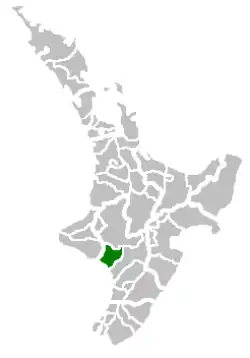Whanganui District
Whanganui District is one of the districts of New Zealand. It includes the city of Whanganui and surrounding areas.
Whanganui District | |
|---|---|
 Whanganui River Bridge View from Helicopter | |
 | |
| Country | New Zealand |
| Region | Manawatū-Whanganui |
| Seat | Whanganui |
| Government | |
| • Mayor | Hamish McDouall (Whanganui District Council) |
| • Deputy Mayor | Jenny Duncan |
| Area | |
| • Total | 2,373 km2 (916 sq mi) |
| Population (June 2020)[1] | |
| • Total | 48,100 |
| • Density | 20/km2 (52/sq mi) |
| Time zone | UTC+12 (NZST) |
| • Summer (DST) | UTC+13 (NZDT) |
| Postcode(s) | |
| Website | Official website |
Geography
Formerly spelled "Wanganui", the Whanganui District Council resulted from the amalgamation of Wanganui and Waitotara county councils and Wanganui City Council. The district has an area of 2,373 km². Much of the land in Whanganui District is rough hill country surrounding the valley of the Whanganui River. A large proportion of this is within the Whanganui National Park.
In 2015 the New Zealand Geographic Board, at the request of the Wanganui District Council, changed the name of the district from Wanganui District to Whanganui District, bringing the name in line with the spelling of the river.[2]
Population
The district's population as of June 2020 was 48,100[1] All but some 5,900 people in the Whanganui District live in the city itself, meaning there are few prominent outlying settlements. A small but notable village is Jerusalem.
Demographics
| Year | Pop. | ±% p.a. |
|---|---|---|
| 2006 | 42,636 | — |
| 2013 | 42,153 | −0.16% |
| 2018 | 45,309 | +1.45% |
| Source: [3] | ||
Whanganui District had a population of 45,309 at the 2018 New Zealand census, an increase of 3,156 people (7.5%) since the 2013 census, and an increase of 2,673 people (6.3%) since the 2006 census. There were 18,057 households. There were 21,912 males and 23,397 females, giving a sex ratio of 0.94 males per female. Of the total population, 8,937 people (19.7%) were aged up to 15 years, 7,692 (17.0%) were 15 to 29, 19,371 (42.8%) were 30 to 64, and 9,309 (20.5%) were 65 or older. Figures may not add up to the total due to rounding.
Ethnicities were 79.2% European/Pākehā, 26.3% Māori, 3.6% Pacific peoples, 4.1% Asian, and 1.7% other ethnicities. People may identify with more than one ethnicity.
The percentage of people born overseas was 12.3, compared with 27.1% nationally.
Although some people objected to giving their religion, 48.3% had no religion, 37.3% were Christian, and 6.4% had other religions.
Of those at least 15 years old, 5,130 (14.1%) people had a bachelor or higher degree, and 8,427 (23.2%) people had no formal qualifications. The median income was $24,400. The employment status of those at least 15 was that 15,159 (41.7%) people were employed full-time, 5,406 (14.9%) were part-time, and 1,866 (5.1%) were unemployed.[3]
References
- "Population estimate tables - NZ.Stat". Statistics New Zealand. Retrieved 22 October 2020.
- Sachdeva, Sam (17 November 2015). "Wanganui to become Whanganui". Stuff. Retrieved 6 January 2016.
- "Statistical area 1 dataset for 2018 Census". Statistics New Zealand. March 2020. Whanganui District (037). 2018 Census place summary: Whanganui District